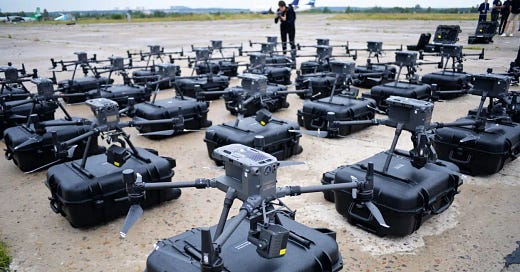Early in July of this year, two Ukrainian soldiers in Donetsk equipped a First Person View (FPV) drone, which has a built in camera, with a rudimentary missile using cable ties. The drone was then guided via a remote control, and a screen showing the view the camera can see, towards a Russian tank which it destroyed upon impact. This FPV drone cost less than $500 and required no specialist training to use, yet the tank it destroyed would have cost between $3-5 million.
The landscape of modern warfare is currently undergoing a dramatic transformation that is likely to have huge ramifications for global security and stability. At the heart of this shift is drone technology or, more precisely, drones equipped with munitions and cameras that can be used to hit targets that would otherwise be risky or costly to aim for. Whilst drone technology, in the context of warfare, is not exactly new, the evolution and adaption that it is currently experiencing has the potential to shift power balances and usher in a period of insecurity.
In the Russia-Ukraine conflict, for example, it has been used for spotting artillery and other such reconnaissance purposes. It has been deployed in swarms to attack infrastructure, such as Russian oil installations, which has proven to be hugely costly for Moscow. It has also been used in kamikaze style ways to conduct precision strikes against tanks and even individual soldiers in trenches or buildings. The conflict has also spurred rapid advancements in anti-drone technologies, including electronic warfare systems and kinetic interceptors that can be used to counter them. These are now being used extensively in Russia-Ukraine as both sides are seeking to counter the constant barrage of drone attacks they experience on an almost daily basis.
There has even been increased testing for drones with autonomous capabilities, as in drones that make their own decisions based on pre-programmed algorithms. Currently, such drones are only being used for surveillance purposes but it would not be a huge technological leap for them to be adapted for military purposes. Putting aside the ethical issues autonomous drones would raise, this increasing convergence of drones and AI could change our understanding of warfare as humans are removed from the equation.
The other convergence of interest is drones with nanotechnology or, in other words, nano drone technology. A number of US-based firms have already developed insect and bird sized drones that can be used for reconnaissance purposes. There has also been research into nano drones equipped with facial recognition technology that could be used to hunt and kill people. These drones would be very hard to detect and counter given their size and ability to be disguised as an insect or bird. Whilst this technology is not currently widely available, or even cheap, it is likely to develop fast given the advantages it offers.
This evolution of drone technology offers numerous unique advantages that can be a real game-changer for global conflict. Firstly, drones offer smaller military forces a relatively inexpensive means to project power and influence conflicts, allowing them to challenge more economically powerful adversaries without incurring the high costs associated with traditional military hardware. Secondly, by utilizing unmanned systems, these nations can conduct precise military operations with minimal risk to their own forces, potentially lowering domestic opposition to military engagements. Thirdly, drones can be used for covert operations, allowing these nations to engage in conflicts while maintaining a degree of deniability.
More worryingly, whilst the US is still the world leader, Iran, Russia, and China have also made significant strides in drone technology, positioning themselves at the vanguard of this revolution. Iran is currently exporting its highly effective Shahed 136 drones to Russia for use in Ukraine. It has already used them against Israel and supplied them to the Houthis for attacks against Saudi oil installations. China, in the meantime, is becoming the world’s leading exporter of Unmanned Aerial Vehicles (UAV) since their hardware is much cheaper than its American competitors and they seem to be selling them to anyone willing to pay. China is also believed to be developing attack drones for Russia which would allow them to replace Iran as key supplier for the current conflict.
Combat-proven drone technologies, some of which are developed by Iran, are likely to be sought after by non-state actors too. This could have devastating consequences if you consider the amount of non-state actors that Iran supports, such as Hezbollah and Hamas. There is also a potential for this technology to fall into the hands of terrorist groups and be used against civilian targets. ISIS is already believed to have drones and is actively using them in Iraq, thus, it is only a matter of time before other jihadist actors get them too. Given their low cost and ease of use, it would be very difficult to prevent attacks in which they are deployed.
The international community must act swiftly and decisively to address the challenges posed by the rise of drone warfare. Failure to do so could result in a more volatile and unpredictable world, where the barriers to conflict are lowered and the potential for escalation is heightened. In theory, we should be working together to establish norms and create ethical frameworks for the use of these technologies. However, given current tensions between the West and the Russia-Iran-China axis, this will be very difficult, especially in the context of declining western power.
Therefore, as drone technology continues to evolve, counter-drone systems must also advance in order to maintain global security. Ongoing research and development in this field remains crucial for addressing this emerging security challenge but first we must develop greater awareness of the dangers of advances in this field. The global proliferation of what are effectively remotely control bombs is a threat we must remain alert to if we are prevent them from wreaking havoc in the years to come.



